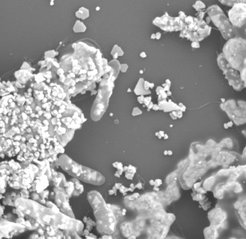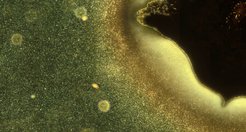In search of the Biofilm storyline
Max Planck and Helmholtz researcher team catches electroactive bacteria Shewanella oneidensis in action
Silver nanoparticles are normally toxic to microorganisms, but some bacteria can actually produce them, for example, Shewanella oneidensis MR-1. A team led by Gal Schkolnik of the Max Planck Institute for Dynamics and Self-Organization in Göttingen (MPIDS) and the Helmholtz Centre for Environmental Research in Leipzig (UFZ) and by Niculina Musat (UFZ), together with Marco G. Mazza (MPIDS) has for the first time nondestructively observed a silver nanoparticle-producing biofilm with both spatial and temporal resolution. The biofilm was created by S. oneidensis bacteria on the surface of a silver/silver chloride containing solid in an aqueous environment. The bioproduced silver nanoparticles have allowed the use of surface enhanced confocal Raman microscopy (SECRaM), a method that can improve scientific understanding of electroactive biofilms. Such electroactive biofilms can for example produce electricity while cleaning wastewater.
An electroactive superhero with lots of technological potential

Like most other living creatures, Shewanella oneidensis bacteria can use oxygen for their survival. However, in the absence of oxygen they can also use other soluble and insoluble substances instead. These include rust, manganese oxide, and even chromium and uranium ions. In this work, researchers have shown that Shewanella can colonize solid surfaces that contain silver ions. The bacteria transform these into silver nanoparticles, both inside and outside their cells. In the past, this could be only achieved by opening the experimental setup to add soluble silver salts. However, now it has been found that the bacteria create a biofilm with silver nanoparticles when allowed to colonize a solid silver salt in an air-tight environment. This eliminates the need for further intervention into the systems (see images).
Biofilms: on the seamline between Biology, Chemistry and Physics
„Biofilms are right there on the seamline between Biology, Chemistry and Physics. We are only now beginning to understand the composition and behavior of biofilms,” Marco G. Mazza (MPIDS) explains. “After all, microorganisms, such as bacteria and fungi, account for most of living matter on Earth.” In the past, researchers had to disturb the growth of biofilms to investigate them. Now Raman microscopy has allowed them, for the first time, to watch this process in action, in an isolated environment. This way, the team of basic researchers could resolve the chemical composition of the biofilms both in space and time. This is a big step on the way to a thorough understanding of biofilms. MPI-DS researcher Mazza gives the following example: “If a bacterium is accidentally present when a cardiac pacemaker is implanted, this single microorganism can multiply and with time build a whole biofilm in the patient’s heart, leading to grave consequences. The better we understand the composition of biofilms, the more we will understand about Life in general. This knowledge can be very useful, not only in medicine, but also for the environment.” Gal Schkolnik elaborates: “ In order to plan and use sustainable technologies based on electroactive biofilms, we first have to understand their composition and function. In this work we have developed a method that will allow us to gain better fundamental knowledge about the chemical composition of biofilms.”

It may look like outer space, but it’s really a biofilm: S. oneidensis bacteria (here seen as bright spots over the dark background) colonize a silver-ion-containing solid interface (top right, black). Where the biofilm has grown thick, next to the solid surface, it looks blurred since the structures built by bacteria refract light. The brownish hue is probably a result of the silver nanoparticles, which due to their optical properties look brownish when in an aqueous suspension.

